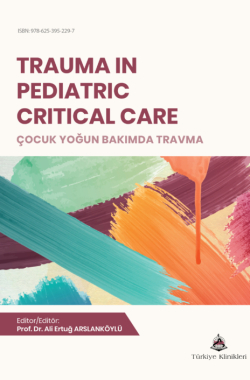Abdominal Trauma
Ali NAYCIa
aMersin University Faculty of Medicine, Department of Pediatric Surgery, Mersin, Türkiye
Naycı A. Abdominal trauma. In: Arslanköylü AE, ed. Trauma in Pediatric Critical Care. 1st ed. Ankara: Türkiye Klinikleri; 2024. p.27-31.
ABSTRACT
Abdominal trauma management in children is a rush against time and performed in correct sequencing. In the approach to the trauma patient, priority is given to basic life support and airwayrespiratory-circulation (ABC) is quickly reviewed. After stabilization of the patient, a short and adequate history and systemic examination are performed. It should be noted that in some cases, rapid diagnosis and surgery will be required for stabilization. It is important that they patients should be observed, especially young children and in cases with high trauma severity, even if there is no concrete diagnosis. Repetition of examinations at regular intervals prevents some injuries from being overlooked. Concentration, skepticism and experience are extremely important for diagnosis. Among the radiological imaging tools, direct radiography, sonography, computed tomography support diagnosis. Laparatomy decision is made according to the patient’s hemodynamic status in blunt trauma, while laparatomy is performed in penetrating injuries, gastrointestinal and colon perforations, and diaphragm injuries.
Keywords: Abdominal trauma; children
Kaynak Göster
Referanslar
- Stylianos S, Pearl RH. Abdominal Trauma. In: Grosfeld JL, O'Neill JA, Coran A, Fonkalsrud EW, eds. Pediatric Surgery. 6th ed. Philadelphia PA: by Mosby Inc; 2006. p. 295-316. [Crossref]
- Eubanks JW, Meier DE, Hicks BA, Joglar J, Guzetta PC. Significance of blush on computed tomography scan in children with liver injury. J Pediatr Surg. 2033;38:363-6. [Crossref] [PubMed]
- Patel JC, Tepas JJ. The efficacy of focused abdominal sonography for trauma (FAST) as a screening tool in the assessment of injured children. J Pediatr Surg. 1999;34:44-7. [Crossref] [PubMed]
- Cusschieri A, Hennessy TP, Stephens RB, Berci G. Diagnosis of significant abdominal trauma after road traffic accidents, preliminary results of a multicentre clinical trial comparing mini laparoscopy with peritoneal lavage. Ann R Coll Surg Engl. 1988;70:153-5.
- Stylianos S. Evidence based guidelines for resources utilization in children with isolated spleen or liver injury. The APSA Trauma Committee: J Pediatr Surg. 2000;35:164-9. [Crossref] [PubMed]
- Norotsky MC, Rogers FB, Shackford SR. Delayed presentation of splenic artery pseudoaneurysms following blunt abdominal trauma: case reports J Trauma. 1995;38:444-7. [Crossref] [PubMed]
- Pryor JP, Stafford PW, Nance ML. Severe blunt hepatic trauma in children. J Pediatr Surg. 2001;36:974-9. [Crossref] [PubMed]
- Brunet C, Sielezneff I, Thomas P, Thirion X, Sastre B, Farisse J. Treatment of hepatic trauma with perihepatic mesh. J Trauma. 1994;37:200-4. [Crossref] [PubMed]
- Shapiro MB, Jenkins DH, Schwab CW, Rotondo MF. Damage control: collective review. J Trauma. 2000;49:969-78. [Crossref] [PubMed]
- Granchi TS, Abikhaled JA, Hirshberg A, Wall MJ, Mattox KL. Patterns of microbiology in intra-abdominal packing for trauma. J Trauma. 2004;56:45-51. [Crossref] [PubMed]
- Yellin AE, Chaffee CB, Donovan AJ. Vascular isolation in treatment of juxtahepatic venous injuries. Arch Surg. 1971;102:566-73. [Crossref] [PubMed]
- Yang EY, Marder SR, Hastings G; Knudson MM. The abdominal compartment syndrome complicating nonoperative management of major blunt liver injuries: recognation and treatment using multimodality therapy. J Trauma. 2002;52:982-6. [Crossref] [PubMed]
- Markley MA, Mantor PC, Letton RW, Tuggle DW. Pediatric vacuum packing wound closure for damage control laparatomy. J Pediatr Surg. 2002;37:512-4. [Crossref] [PubMed]
- Scioscia PJ, Dillon PW, Cillery RE, Hoover WC, Krummel TM. Endoscopic sphincterotomy in the management of posttraumatic billiary fistula. J Pediatr Surg. 1994;29:3-6. [Crossref] [PubMed]
- Ballard RB, Badellino MM, Eynon CA, Spott MA, Staz CF, Buckman Jr RF. Blunt duodenal rupture: a 6-year statewide review. J Trauma. 1997;43:729-33. [Crossref] [PubMed]
- Shilyansky J, Pear RH, Kreller M, Sena LM, Babyn PS. Diagnosis and management of duodenal injuries in children. J Pediatr Surg. 1997;32:880-6. [Crossref] [PubMed]
- Wales PW, Shuckett B, Kim PC. Long term outcome of nonoperative management of complete traumatic pancreatic transsection in children. J Pediatr Surg. 2001;36:823-7. [Crossref] [PubMed]
- Lucaya J, Vasques E, Caballero F, Chait PG, Daneman A, Wesson D. Nonoperative management of traumatic pancreatic pseudocysts associated with pancreatic duct laceration in children. Pediatric Radiol. 1998;28:5-8. [Crossref] [PubMed]
- Canty TG, Weinman D. Management of major pancreatic duct injuries in children. J Trauma. 2001;50:1001-7. [Crossref] [PubMed]
- Bosman-Vermeeren JM, Vermeeren-Walters G, Broos P, Eggermont E. Somatostatin in the treatment of a pancreatic pseudocyst in a child. J Pediatr Gastroenterol Nutr. 1996;23:422-5. [Crossref] [PubMed]
- Moss RL, Musemeche CA. Clinical judgment is superior to diagnose tests in the management of pediatric small bowel injury. J Pediatr Surg. 1996;8:1178-81. [Crossref] [PubMed]
- Kaddish HA, Schunk JE, Britton H. Pediatric male rectal and genital trauma: accidental and nonaccidental injuries. Pediatric Emerg Care. 1998;14:95-8. [Crossref] [PubMed]
- Ramos CT, Koplewitz BZ, Babyn PS, Manson PS, Ein SH. What have we learned about traumatic diaphragmatic hernias in children? J Pediatr Surg. 2000;35:601-4. [Crossref] [PubMed]

